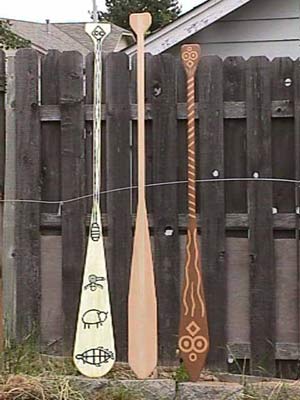Making Canoe Paddles
By Andrew Linn
www.andrewlinn.com
Canoe paddles are one of the cheapest and easiest
things to make and are great for expressing your creativity and
individuality. A unique, one of a kind canoe paddle usually costs
less than $3 and can be ready to paint in 2 short work sessions,
maybe 30 minutes for the first session and 45 for the second.

Tools for this project:
2 clamps that open at least 8 inches
2 clamps that open at least 2 inches
2-3 clamps (or so) that open between 2 and 8 inches
Jigsaw or some such wood cutting device
Plane (power plane is fast and fun)
and I recommend a belt sander
Materials for this project:
2x2 or wooden closet rod at least as long as the distance from
the floor to your chin
36 inch long 1x3
waterproof glue
sandpaper
paint/varnish and brushes
I like to use wooden closet rods for the paddle shaft. Some people
like to take 2x2s and knock the corners off, but I discovered
a discount lumber yard that sells 6' closet rods for a buck, and
that works for me.
Step 1: Measuring (twice, then cutting once)
The rule of thumb for canoe paddles is "When stood on end,
a paddle should come up to your chin." Me, I like 'em to
come up to my eyeballs. Make your choice, measure the shaft, and
make your cut.

For the handle and blades, I measure up 4 inches from the end
of the 1x3 and make a mark, then connect the dots in a zigzag
pattern. The large triangles become the blades, and I cut about
an inch off the outside corner of the small triangle (cut with
the grain) so the handles fit better in my hand.

Experiment with the shape of the blade (and thereby the shape
of the handle.) I like the angular blade, but have made rounded
paddles as well.
At this point, I like to clamp the blades together and use the
belt sander to remove any differences. I do the same thing with
the handles.
Step 2: Planeing the Shaft
Lay the blade along the shaft and draw a line around it. You need
to plane a flat spot on the shaft at least that big. Repeat with
the other blade on the opposite side, then do the same process
with the handles. It is important that you get the flats opposite
each other, otherwise your blades/handles may come out crooked.

Step 3: Attaching the Blades and Handles
Apply your glue according to the directions. I like to use Elmer's
Ultimate Glue, which is the same type of waterproof polyester
glue as Gorilla Glue, only cheaper. TiteBond II works as well,
but it doesn't expand during curing like the polyesters.

With Elmer's Ultimate Glue (or Gorilla Glue), I dampen both surfaces,
apply a thin coating of the glue to one surface, and then stick
the surfaces together. This gets tricky, holding two slippery,
36" long blades on opposite sides of the shaft, so I position
the top of the blades first and hold them in place with a small
clamp, then make sure the blades are lined up and clamp them in
place at the widest part with a big clamp. I then space out the
clamps as needed, trying to put a clamp every 5-6 inches.
Repeat with the handles, then lock up for the night as the glue
cures.
Step 4: Shaping the Paddle
After the glue has completely cured (I let it stand overnight
- no matter what the instructions say,) plane down the excess
shaft at the blades and handle.
The main areas of stress on the paddle will be where the top
of the blades connect with the shaft and where your lower hand
is on the shaft while paddling, so I like to keep these areas
as thick as possible, 3/4" (or just a tad more) where the
blades/handles meet the shaft and maybe flattening the shaft just
a bit for comfort and aesthetics.
I plane the blades and handles to 1/2" - 3/8" thickness
a the outer edge, then use the belt sander to round the edges
and corners.

I do a final sanding with a finish (orbital) sander to make everything
look nice, then paint as my fancy takes me.
Andrew Linn
www.andrewlinn.com
|

